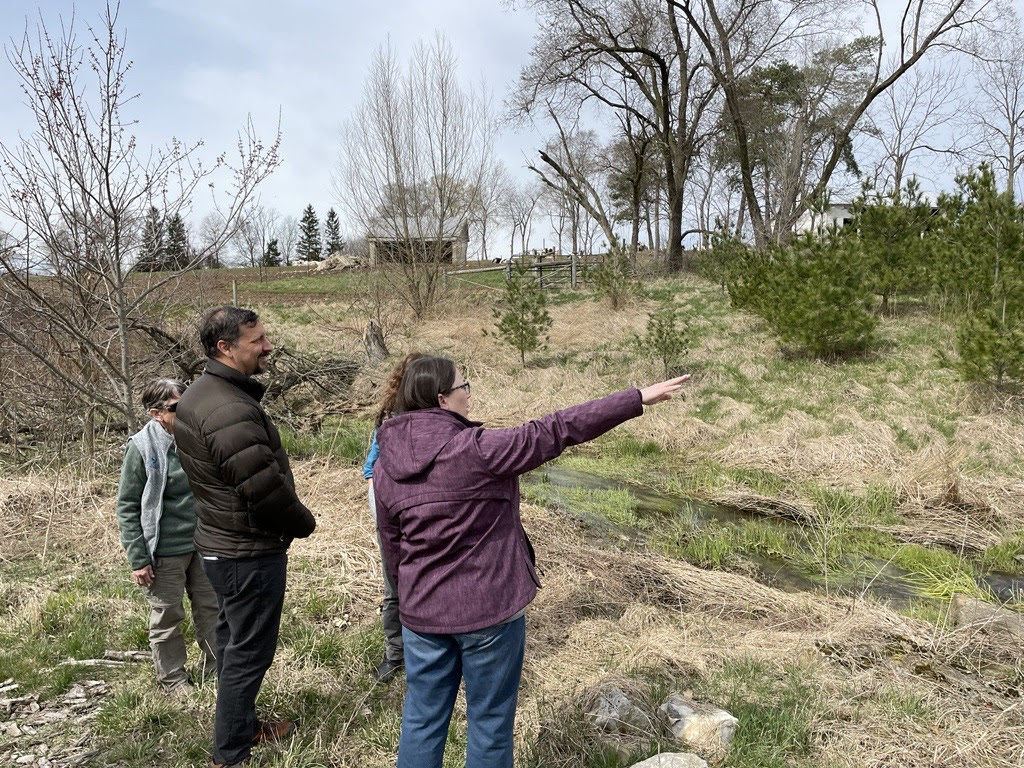A U.S. Environmental Protection Agency official visited with local conservation leaders this week to see efforts to preserve land and protect water quality in Centre County.
EPA Regional Administrator Adam Ortiz joined ClearWater Conservancy staff on Wednesday to tour several conservation sites in the Halfmoon Creek Watershed. They discussed how ClearWater identifies opportunities, how it is leveraging funding made available through the Infrastructure Investment and Jobs Act and how even small projects can have an impact on water quality.
“From Centre County to the Chesapeake Bay, we’re seeing the positive impact organizations like ClearWater Conservancy are having on water quality, both locally and downstream,” Ortiz said in a news release. “Every mile of stream restored, every bank stabilized, and every riparian buffer planted makes a difference. It’s remarkable to see how federal dollars, partnerships, and a vision can deliver tangible solutions to intractable problems.”
The EPA awarded more than $430,000 in grants for the Halfmoon Creek Watershed Implementation Plan in 2023. The Section 319 “is used to address non-point source pollution, typically from agriculture or stormwater, in areas that have an approved watershed plan,” according to the release.
Among the sites visited was the Radzwich Farm along the Beaver Branch of Spruce Creek, where beginning in 2017 ClearWater worked with several partners, including the Radzwich Family, on conservation efforts. Those measures included restoring and stabilizing 3.8 acres of stream bank, planting a riparian buffer and installing fencing and livestock crossings that allowed animals access to all pastures but kept them out of the stream.
“Having the opportunity to personally show EPA leadership the work we’re doing in Centre County — from partnering with landowners to getting federal dollars on the ground — is a testament to the commitment this administration has to the environment,” Donnan Stoicovy, interim executive director of ClearWater Conservancy, said. “From Spruce Creek down to the Bay, we’re working hard and we’re working together to improve our waters.”
Since 1980, ClearWater has conserved over 3,100 acres of land through easements and ownership, while also working to repair streams, stabilize banks and restore the natural landscape.
On Tuesday, Ortiz spoke at the PA Brownfields Conference at the Penn Stater Hotel and Conference Center. Brownfields are sites that are contaminated or potentially contaminated by pollutants or hazardous substances, making their reuse difficult. State and federal programs aim to clean up the sites for reinvestment and development.
“Brownfields programs hold significant power, and we know these remediation, restoration and revitalization efforts change lives and communities all across the Commonweatlh,” Ortiz said. “When we come together, align our priorities and goals and commit to seeing projects through, we’re telling our present and future communities that they’re worth it.”
The EPA awarded a total of $14 million to 19 grantees across Pennsylvania for assessments, cleanups and revolving loan funds in 2023. The agency currently has 50 open Brownfields grants across 35 grantees in the commonwealth.
“Pennsylvania has a rich industrial history with thousands of revitalized Brownfields sites and many more sites across the Commonwealth are currently undergoing the cleanup process,” state Department of Environmental Protection Acting Executive Deputy Ramez Ziadeh said. “Brownfield projects can both restore the environment and contribute to greater economic development for businesses and communities. The success of our Brownfield Redevelopment program would not be possible without our collaborative partnerships with U.S. EPA and other state agencies. DEP is committed to connecting communities and transforming sites into places where people want to live, work and visit through brownfield redevelopment.”



